Abstract
From July 1985 to March 1987, the occurrence of motile Aeromonas sp. in stool, food and environmental specimens was investigated to assess their pathogenic significance and to determine sources and routes of infection. A total of 9366 stool specimens were examined; Aeromonas was isolated from 11.1% of diarrhoeal stools and 2.2% of normal stools (P less than 0.001). Aeromonas counts in food specimens, which included minced beef, pork and chicken, seafood and various vegetables and their products, were unexpectedly high suggesting that infection might be food-borne rather than water-borne. About 70% of the isolates from meat products were A. hydrophila and A. sobria, while A. caviae was the most common in sea-fish, vegetables and their products. Most A. hydrophila and A. sobria strains produced haemolysin, but haemagglutinin was found more frequently in A. sobria.
Full text
PDF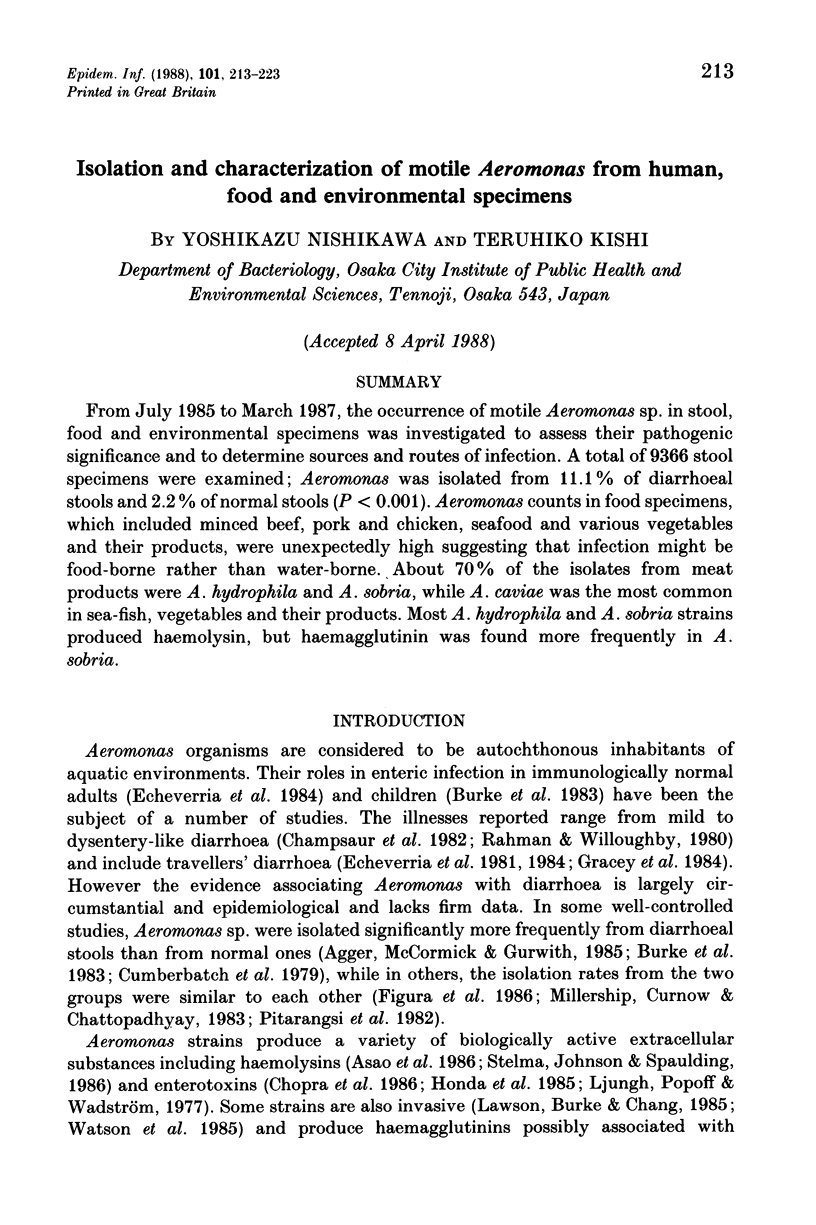
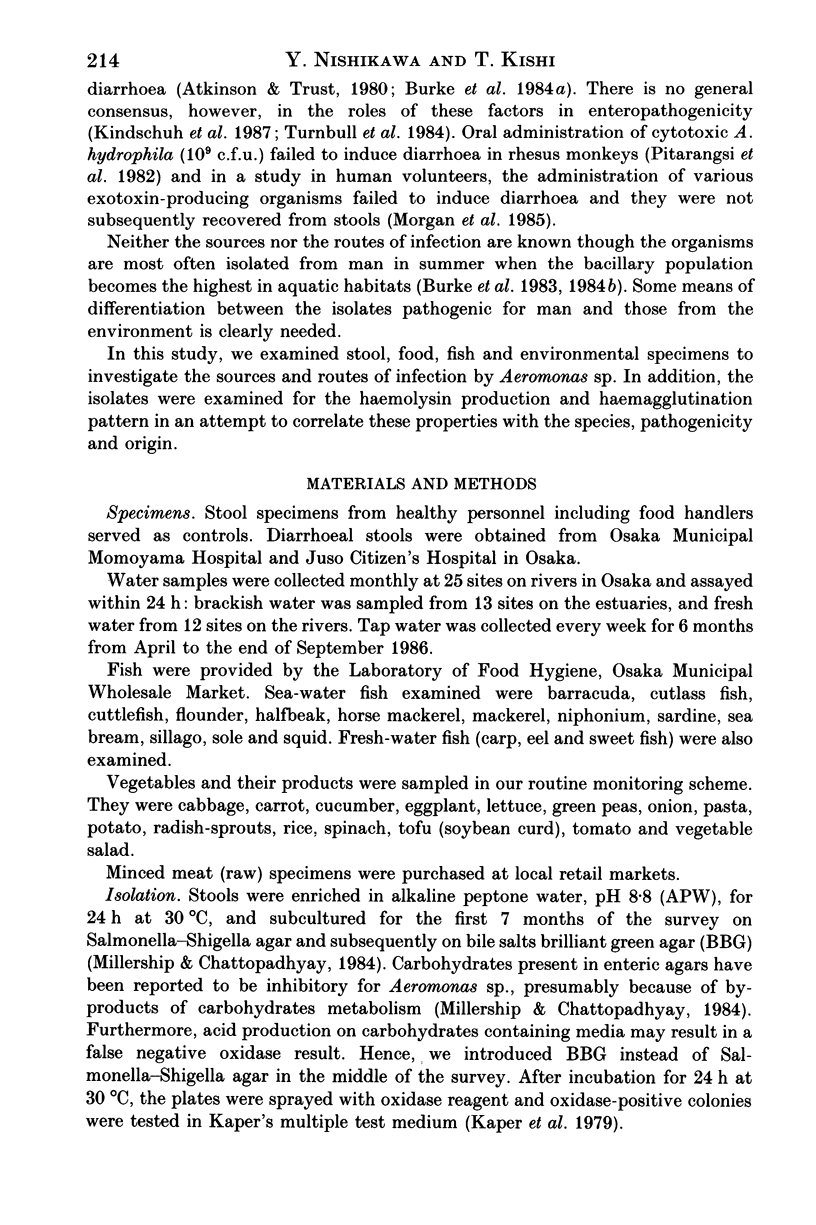
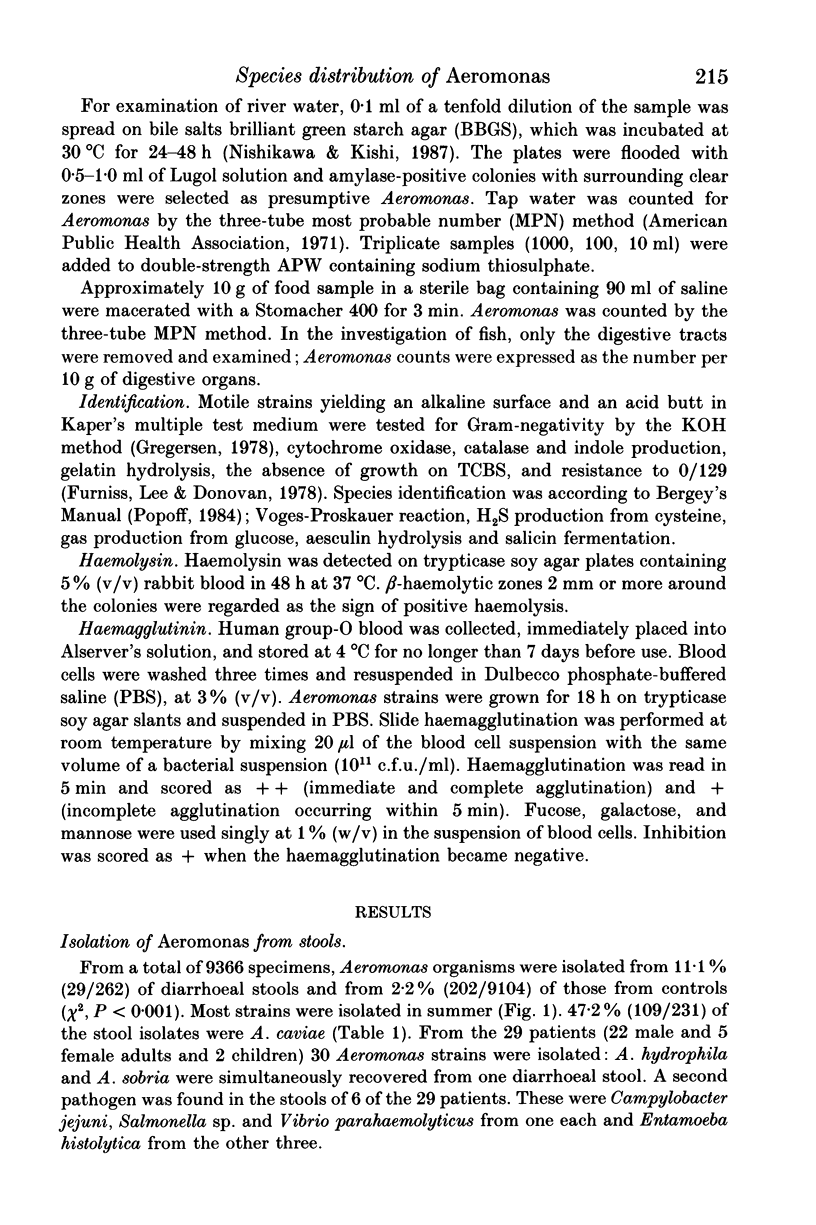
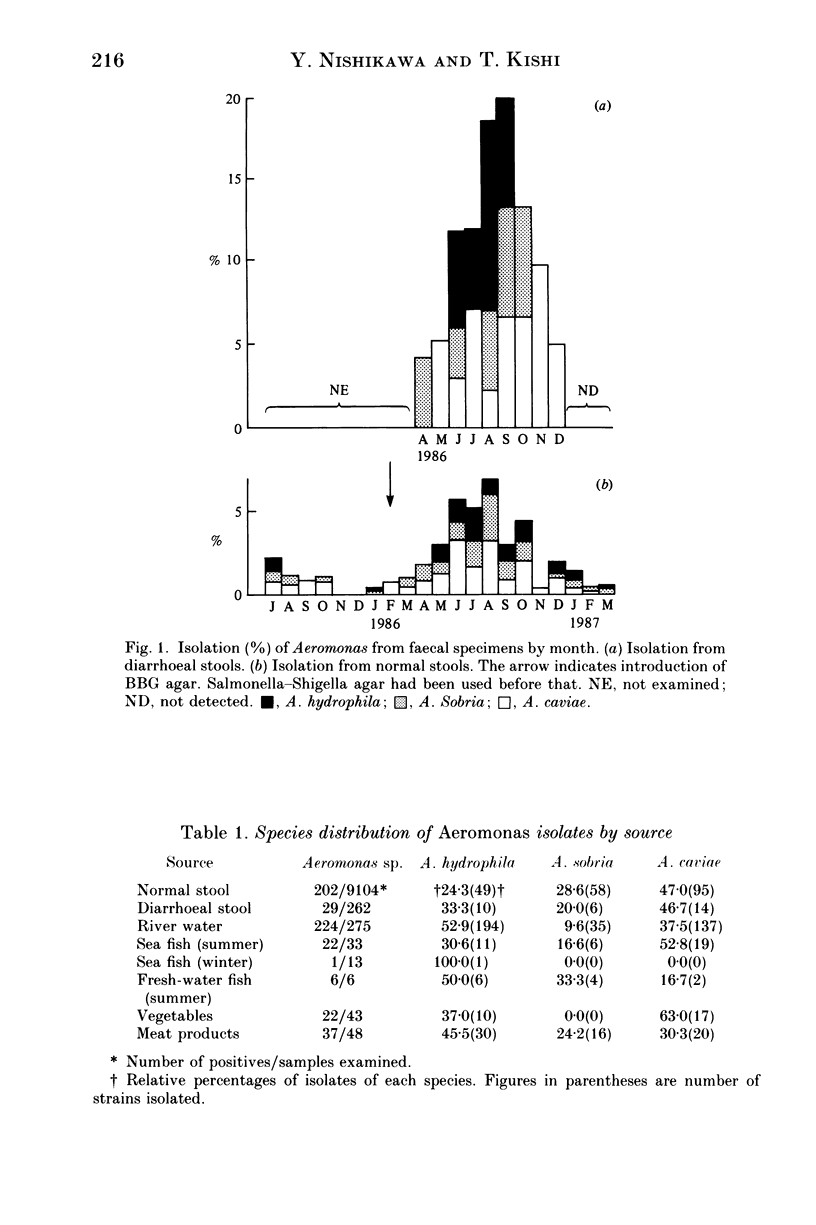
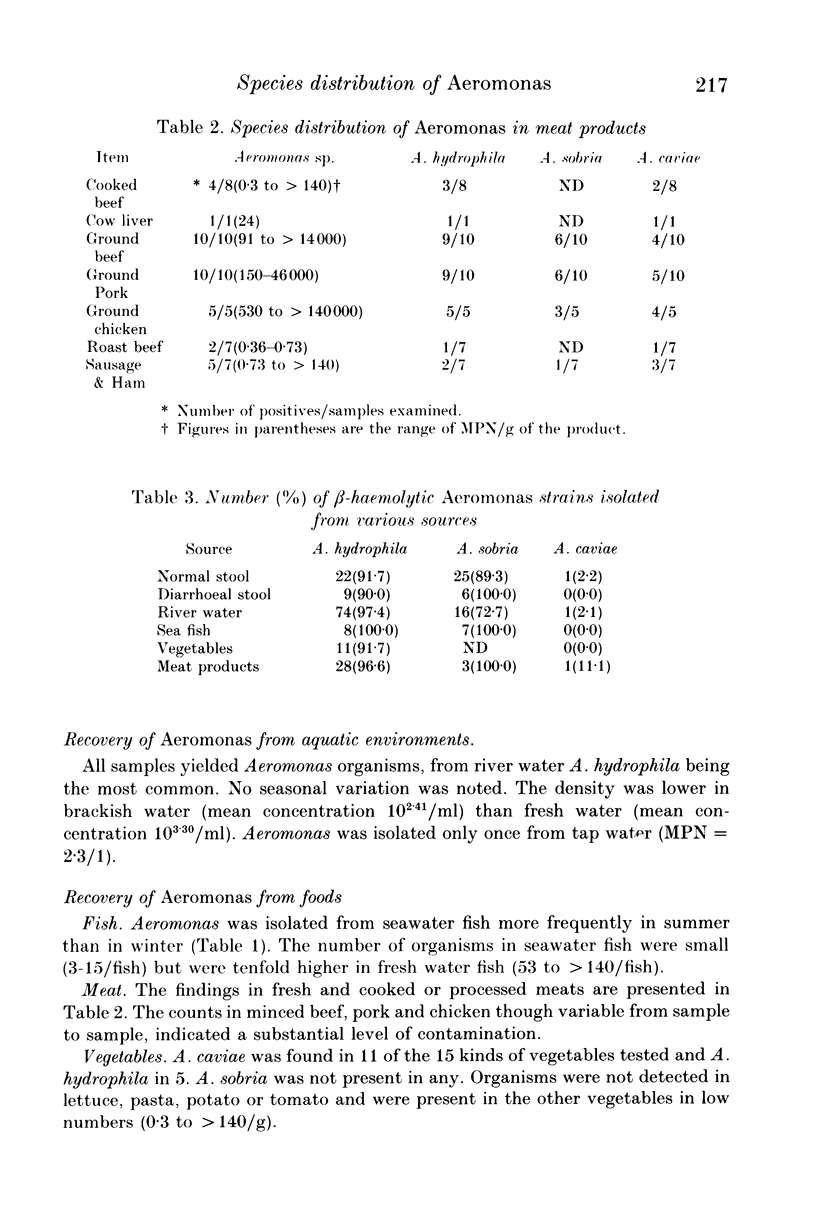
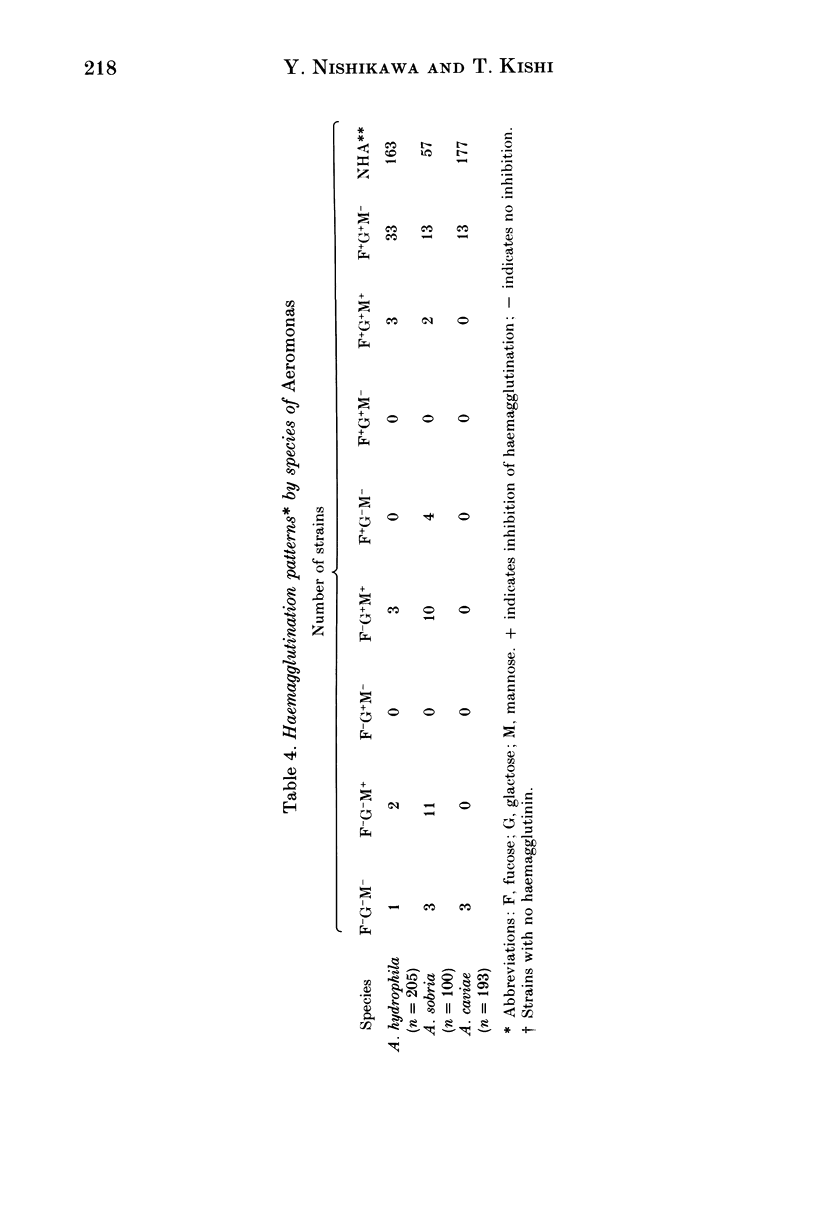
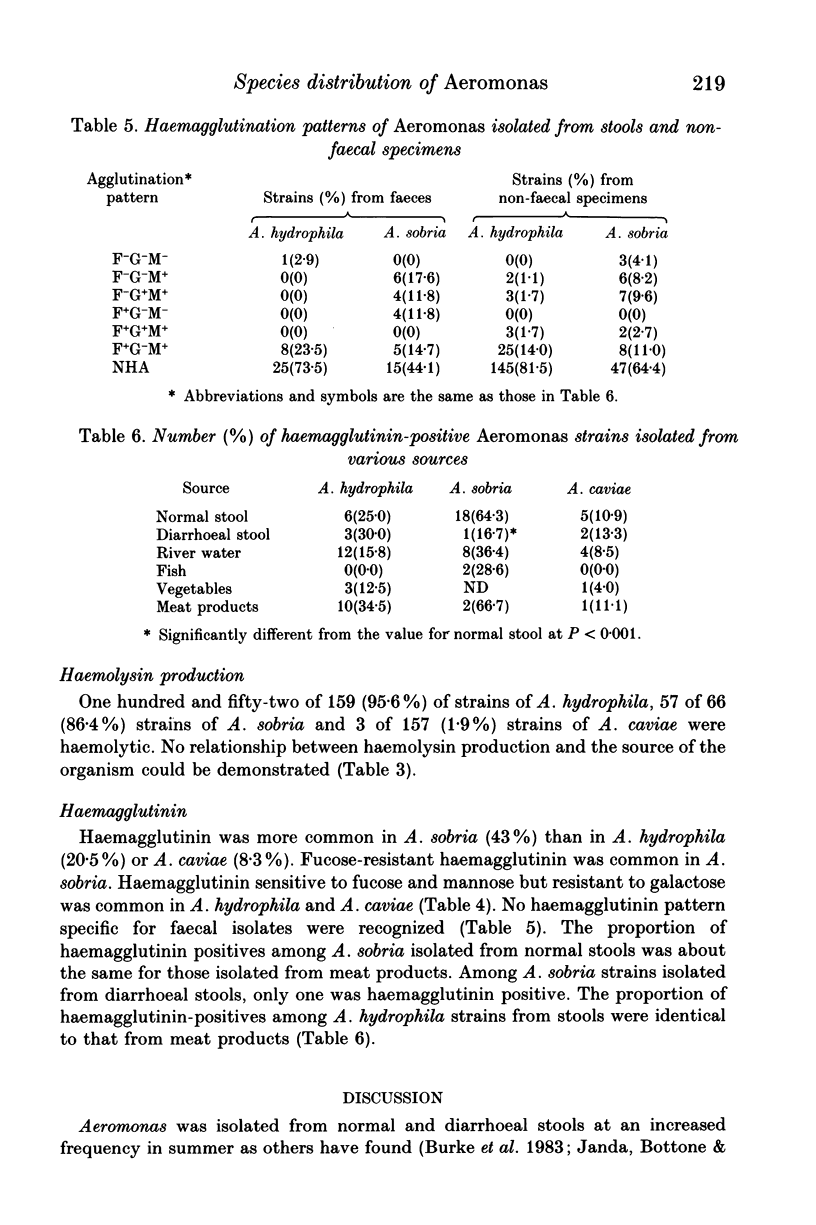
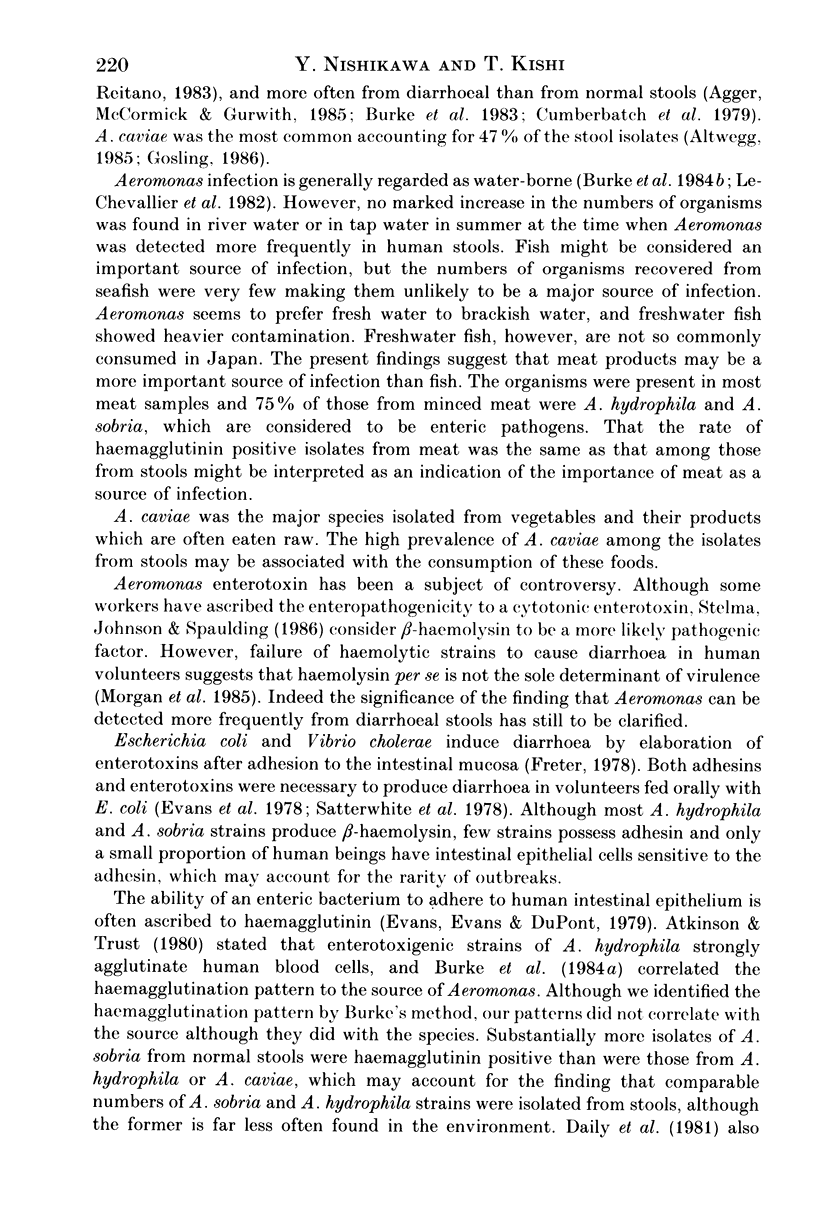
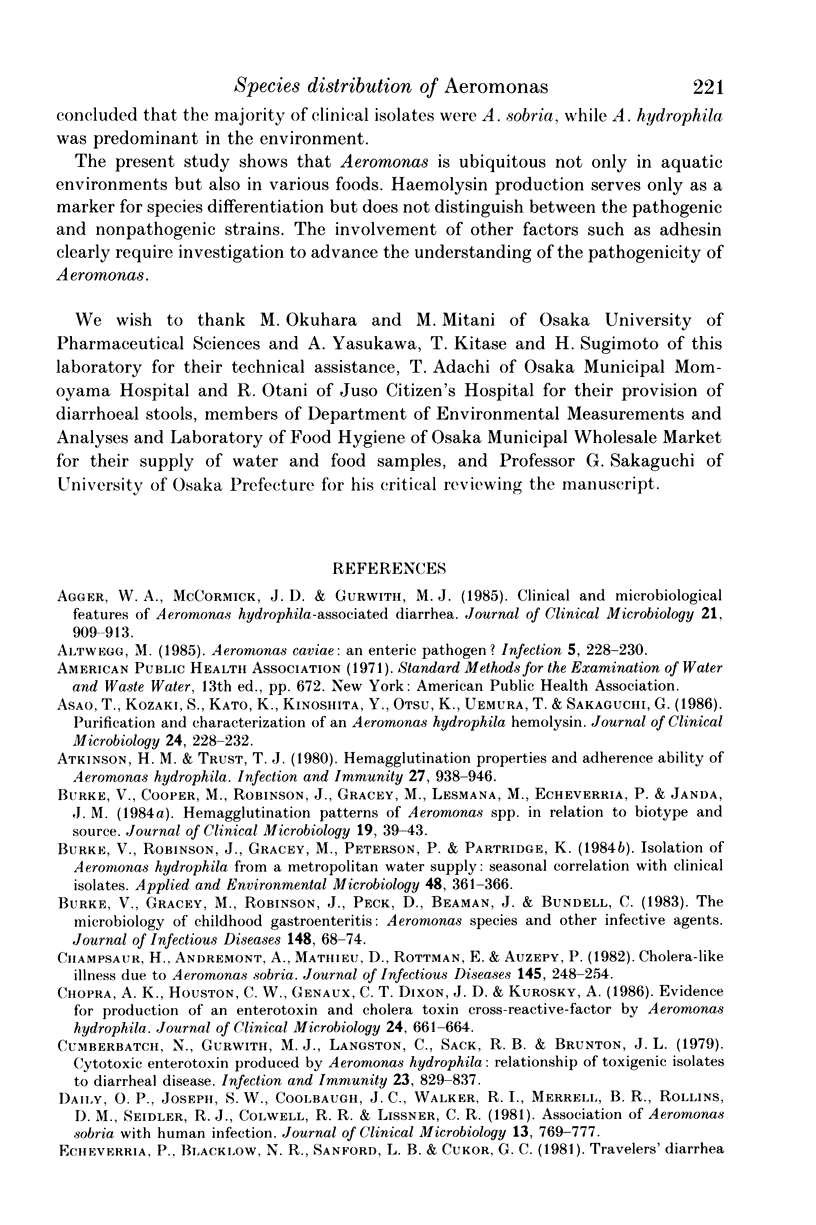
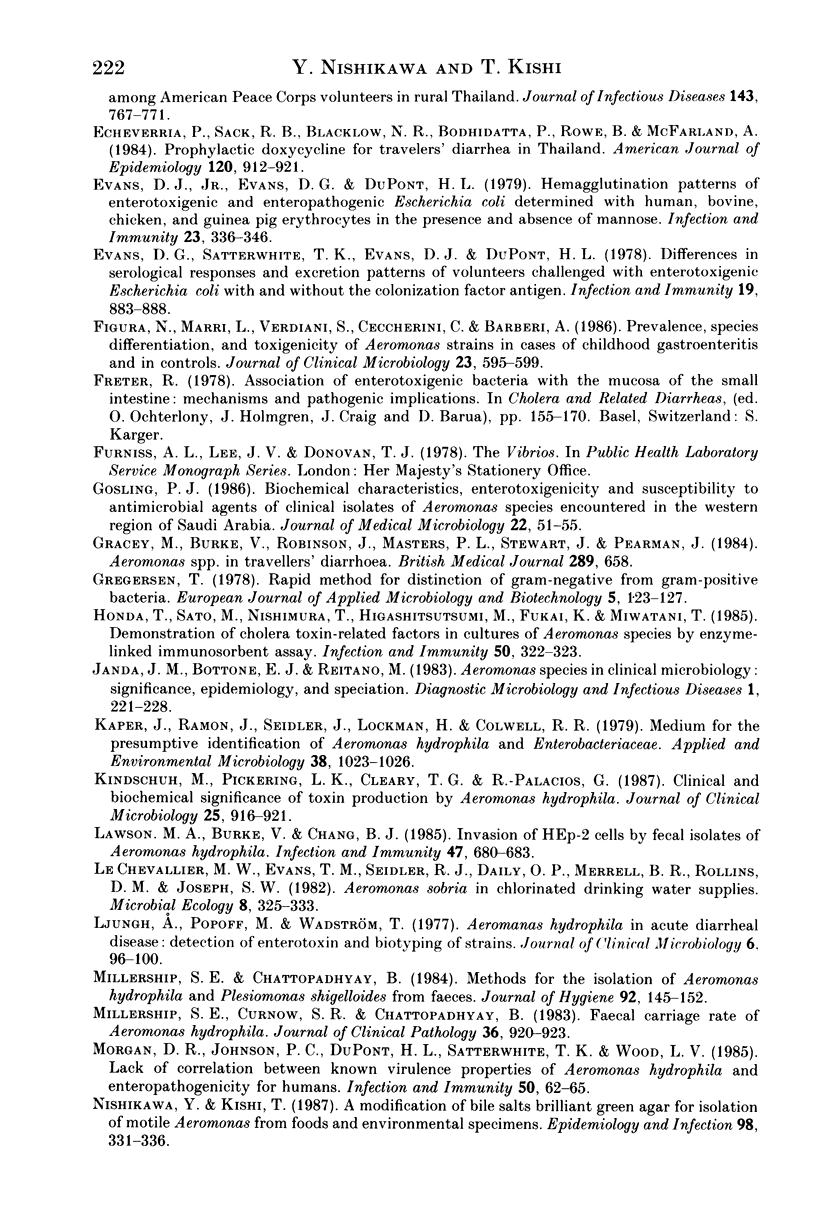
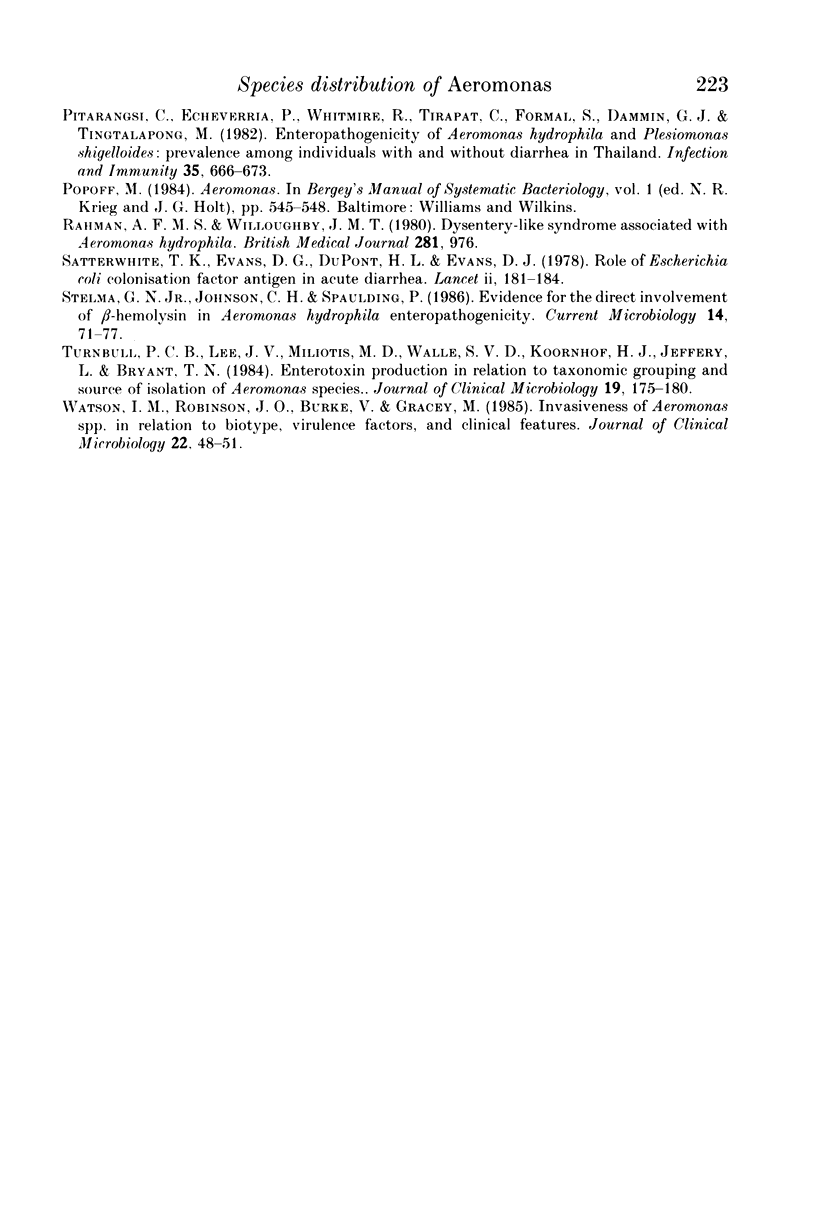
Selected References
These references are in PubMed. This may not be the complete list of references from this article.
- Agger W. A., McCormick J. D., Gurwith M. J. Clinical and microbiological features of Aeromonas hydrophila-associated diarrhea. J Clin Microbiol. 1985 Jun;21(6):909–913. doi: 10.1128/jcm.21.6.909-913.1985. [DOI] [PMC free article] [PubMed] [Google Scholar]
- Altwegg M. Aeromonas caviae: an enteric pathogen? Infection. 1985 Sep-Oct;13(5):228–230. doi: 10.1007/BF01667217. [DOI] [PubMed] [Google Scholar]
- Asao T., Kozaki S., Kato K., Kinoshita Y., Otsu K., Uemura T., Sakaguchi G. Purification and characterization of an Aeromonas hydrophila hemolysin. J Clin Microbiol. 1986 Aug;24(2):228–232. doi: 10.1128/jcm.24.2.228-232.1986. [DOI] [PMC free article] [PubMed] [Google Scholar]
- Atkinson H. M., Trust T. J. Hemagglutination properties and adherence ability of Aeromonas hydrophila. Infect Immun. 1980 Mar;27(3):938–946. doi: 10.1128/iai.27.3.938-946.1980. [DOI] [PMC free article] [PubMed] [Google Scholar]
- Burke V., Cooper M., Robinson J., Gracey M., Lesmana M., Echeverria P., Janda J. M. Hemagglutination patterns of Aeromonas spp. in relation to biotype and source. J Clin Microbiol. 1984 Jan;19(1):39–43. doi: 10.1128/jcm.19.1.39-43.1984. [DOI] [PMC free article] [PubMed] [Google Scholar]
- Burke V., Gracey M., Robinson J., Peck D., Beaman J., Bundell C. The microbiology of childhood gastroenteritis: Aeromonas species and other infective agents. J Infect Dis. 1983 Jul;148(1):68–74. doi: 10.1093/infdis/148.1.68. [DOI] [PubMed] [Google Scholar]
- Burke V., Robinson J., Gracey M., Peterson D., Partridge K. Isolation of Aeromonas hydrophila from a metropolitan water supply: seasonal correlation with clinical isolates. Appl Environ Microbiol. 1984 Aug;48(2):361–366. doi: 10.1128/aem.48.2.361-366.1984. [DOI] [PMC free article] [PubMed] [Google Scholar]
- Champsaur H., Adremont A., Mathieu D., Rottman E., Auzepy P. Cholera-like illness due to Aeromonas sobria. J Infect Dis. 1982 Feb;145(2):248–254. doi: 10.1093/infdis/145.2.248. [DOI] [PubMed] [Google Scholar]
- Chopra A. K., Houston C. W., Genaux C. T., Dixon J. D., Kurosky A. Evidence for production of an enterotoxin and cholera toxin cross-reactive factor by Aeromonas hydrophila. J Clin Microbiol. 1986 Oct;24(4):661–664. doi: 10.1128/jcm.24.4.661-664.1986. [DOI] [PMC free article] [PubMed] [Google Scholar]
- Cumberbatch N., Gurwith M. J., Langston C., Sack R. B., Brunton J. L. Cytotoxic enterotoxin produced by Aeromonas hydrophila: relationship of toxigenic isolates to diarrheal disease. Infect Immun. 1979 Mar;23(3):829–837. doi: 10.1128/iai.23.3.829-837.1979. [DOI] [PMC free article] [PubMed] [Google Scholar]
- Daily O. P., Joseph S. W., Coolbaugh J. C., Walker R. I., Merrell B. R., Rollins D. M., Seidler R. J., Colwell R. R., Lissner C. R. Association of Aeromonas sobria with human infection. J Clin Microbiol. 1981 Apr;13(4):769–777. doi: 10.1128/jcm.13.4.769-777.1981. [DOI] [PMC free article] [PubMed] [Google Scholar]
- Echeverria P., Sack R. B., Blacklow N. R., Bodhidatta P., Rowe B., McFarland A. Prophylactic doxycycline for travelers' diarrhea in Thailand. Further supportive evidence of Aeromonas hydrophila as an enteric pathogen. Am J Epidemiol. 1984 Dec;120(6):912–921. doi: 10.1093/oxfordjournals.aje.a113962. [DOI] [PubMed] [Google Scholar]
- Evans D. G., Satterwhite T. K., Evans D. J., Jr, DuPont H. L. Differences in serological responses and excretion patterns of volunteers challenged with enterotoxigenic Escherichia coli with and without the colonization factor antigen. Infect Immun. 1978 Mar;19(3):883–888. doi: 10.1128/iai.19.3.883-888.1978. [DOI] [PMC free article] [PubMed] [Google Scholar]
- Evans D. J., Jr, Evans D. G., DuPont H. L. Hemagglutination patterns of enterotoxigenic and enteropathogenic Escherichia coli determined with human, bovine, chicken, and guinea pig erythrocytes in the presence and absence of mannose. Infect Immun. 1979 Feb;23(2):336–346. doi: 10.1128/iai.23.2.336-346.1979. [DOI] [PMC free article] [PubMed] [Google Scholar]
- Figura N., Marri L., Verdiani S., Ceccherini C., Barberi A. Prevalence, species differentiation, and toxigenicity of Aeromonas strains in cases of childhood gastroenteritis and in controls. J Clin Microbiol. 1986 Mar;23(3):595–599. doi: 10.1128/jcm.23.3.595-599.1986. [DOI] [PMC free article] [PubMed] [Google Scholar]
- Gosling P. J. Biochemical characteristics, enterotoxigenicity and susceptibility to antimicrobial agents of clinical isolates of Aeromonas species encountered in the western region of Saudi Arabia. J Med Microbiol. 1986 Aug;22(1):51–55. doi: 10.1099/00222615-22-1-51. [DOI] [PubMed] [Google Scholar]
- Gracey M., Burke V., Robinson J., Masters P. L., Stewart J., Pearman J. Aeromonas spp in travellers' diarrhoea. Br Med J (Clin Res Ed) 1984 Sep 15;289(6446):658–658. doi: 10.1136/bmj.289.6446.658. [DOI] [PMC free article] [PubMed] [Google Scholar]
- Honda T., Sato M., Nishimura T., Higashitsutsumi M., Fukai K., Miwatani T. Demonstration of cholera toxin-related factor in cultures of Aeromonas species by enzyme-linked immunosorbent assay. Infect Immun. 1985 Oct;50(1):322–323. doi: 10.1128/iai.50.1.322-323.1985. [DOI] [PMC free article] [PubMed] [Google Scholar]
- Janda J. M., Bottone E. J., Reitano M. Aeromonas species in clinical microbiology: significance, epidemiology, and speciation. Diagn Microbiol Infect Dis. 1983 Sep;1(3):221–228. doi: 10.1016/0732-8893(83)90021-4. [DOI] [PubMed] [Google Scholar]
- Kaper J., Seidler R. J., Lockman H., Colwell R. R. Medium for the presumptive identification of Aeromonas hydrophila and Enterobacteriaceae. Appl Environ Microbiol. 1979 Nov;38(5):1023–1026. doi: 10.1128/aem.38.5.1023-1026.1979. [DOI] [PMC free article] [PubMed] [Google Scholar]
- Kindschuh M., Pickering L. K., Cleary T. G., Ruiz-Palacios G. Clinical and biochemical significance of toxin production by Aeromonas hydrophila. J Clin Microbiol. 1987 May;25(5):916–921. doi: 10.1128/jcm.25.5.916-921.1987. [DOI] [PMC free article] [PubMed] [Google Scholar]
- Lawson M. A., Burke V., Chang B. J. Invasion of HEp-2 cells by fecal isolates of Aeromonas hydrophila. Infect Immun. 1985 Mar;47(3):680–683. doi: 10.1128/iai.47.3.680-683.1985. [DOI] [PMC free article] [PubMed] [Google Scholar]
- Ljungh A., Popoff M., Wadstrom T. Aeromonas hydrophila in acute diarrheal disease: detection of enterotoxin and biotyping of strains. J Clin Microbiol. 1977 Aug;6(2):96–100. doi: 10.1128/jcm.6.2.96-100.1977. [DOI] [PMC free article] [PubMed] [Google Scholar]
- Millership S. E., Chattopadhyay B. Methods for the isolation of Aeromonas hydrophila and Plesiomonas shigelloides from faeces. J Hyg (Lond) 1984 Apr;92(2):145–152. doi: 10.1017/s0022172400064159. [DOI] [PMC free article] [PubMed] [Google Scholar]
- Millership S. E., Curnow S. R., Chattopadhyay B. Faecal carriage rate of Aeromonas hydrophila. J Clin Pathol. 1983 Aug;36(8):920–923. doi: 10.1136/jcp.36.8.920. [DOI] [PMC free article] [PubMed] [Google Scholar]
- Morgan D. R., Johnson P. C., DuPont H. L., Satterwhite T. K., Wood L. V. Lack of correlation between known virulence properties of Aeromonas hydrophila and enteropathogenicity for humans. Infect Immun. 1985 Oct;50(1):62–65. doi: 10.1128/iai.50.1.62-65.1985. [DOI] [PMC free article] [PubMed] [Google Scholar]
- Nishikawa Y., Kishi T. A modification of bile salts brilliant green agar for isolation of motile Aeromonas from foods and environmental specimens. Epidemiol Infect. 1987 Jun;98(3):331–336. doi: 10.1017/s0950268800062087. [DOI] [PMC free article] [PubMed] [Google Scholar]
- Pitarangsi C., Echeverria P., Whitmire R., Tirapat C., Formal S., Dammin G. J., Tingtalapong M. Enteropathogenicity of Aeromonas hydrophila and Plesiomonas shigelloides: prevalence among individuals with and without diarrhea in Thailand. Infect Immun. 1982 Feb;35(2):666–673. doi: 10.1128/iai.35.2.666-673.1982. [DOI] [PMC free article] [PubMed] [Google Scholar]
- Rahman A. F., Willoughby J. M. Dysentery-like syndrome associated with Aeromonas hydrophila. Br Med J. 1980 Oct 11;281(6246):976–976. doi: 10.1136/bmj.281.6246.976. [DOI] [PMC free article] [PubMed] [Google Scholar]
- Satterwhite T. K., Evans D. G., DuPont H. L., Evans D. J., Jr Role of Escherichia coli colonisation factor antigen in acute diarrhoea. Lancet. 1978 Jul 22;2(8082):181–184. doi: 10.1016/s0140-6736(78)91921-9. [DOI] [PubMed] [Google Scholar]
- Turnbull P. C., Lee J. V., Miliotis M. D., Van de Walle S., Koornhof H. J., Jeffery L., Bryant T. N. Enterotoxin production in relation to taxonomic grouping and source of isolation of Aeromonas species. J Clin Microbiol. 1984 Feb;19(2):175–180. doi: 10.1128/jcm.19.2.175-180.1984. [DOI] [PMC free article] [PubMed] [Google Scholar]
- Watson I. M., Robinson J. O., Burke V., Gracey M. Invasiveness of Aeromonas spp. in relation to biotype, virulence factors, and clinical features. J Clin Microbiol. 1985 Jul;22(1):48–51. doi: 10.1128/jcm.22.1.48-51.1985. [DOI] [PMC free article] [PubMed] [Google Scholar]


